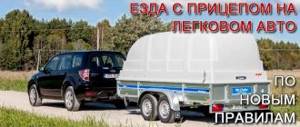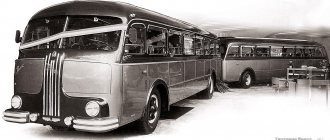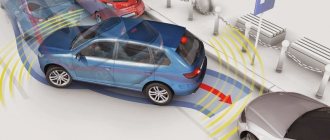About the established rules for driving with a trailer
Recently, there have been constant changes or additions to traffic rules regarding various issues.
According to the new rules, a tow hitch is also a vehicle and in cases specified by law, namely for legal entities and when transporting goods over 3.5 tons, it must be registered, and the driver when transporting goods exceeding the total weight of 3.5 tons of the road train must have the appropriate category “E” on your driver’s license.
There are more different nuances regarding the transportation of cargo in a trailer, and the order of qualification groups in the traffic rules has expanded; when passing the exam to drive a vehicle with a trailer, the driver must have a certain driver’s category in his license.
The answer to the question of how to drive with a trailer and what documents are needed when driving a vehicle is as follows:
- Driving with a trailer in a passenger car without documents is prohibited; a traffic police officer may issue a fine if a violation is detected;
- The towbar must be registered and have only standard certified towbar coupling devices. Homemade devices without certificates are prohibited;
- The trailer must have working lighting, signaling and dimensional devices that allow you to indicate the movement of the tow hitch and its maneuvers on the road, as well as rear-view mirrors with adjustable extensions that allow you to see the overview of the trailer in motion;
- According to established traffic rules, when driving with a trailer as part of a road train with a total weight of up to 3.5 tons on highways, outside populated areas, the vehicle speed should not exceed 90 km per hour. And on other highways at more than 70 km per hour or according to the established speed limits;
- A driver with license category “B” has the right to use a trailer with a weight not exceeding the weight of the tractor and the total weight of the road train should not exceed 3.5 tons;
- When using a trailer, the permissible overall dimensions of the towing device must be observed; the width is no more than 2.55 m, the height is up to 4 m and the total length of the road train, tractor with trailer should not be more than 20 meters;
- In conditions with limited visibility, it is not recommended to use a towed mechanism on the road;
- The trailer should be used only for its intended purpose, it is prohibited to transport people in the trailer, and it is also forbidden to use the trailer when the visibility of the cargo is poor, when the warning devices, registration sign are covered, or when the towed vehicle is unstable;
- The towbar must have wheel wedges in its design in case of an emergency stop on a sloped road.
Driving a car with a trailer
Driving a car with a trailer requires compliance with certain rules that will make driving with a trailer much easier. If you are going to travel on a train with a trailer, we strongly recommend that you read this article.
Not every load can be transported in the trunk of a car. Summer residents, rural residents, outdoor enthusiasts and many other categories of car owners use single-axle passenger trailers in order to expand the capabilities of their car. In addition to convenience, using a trailer is beneficial from an economic point of view. The unit cost of transporting cargo with a trailer is reduced by an average of one third, which is important given high fuel prices.
To experience all the benefits of using a trailer, you must follow certain operating rules, since driving in this case has its own characteristics and requires training of both the driver and the vehicle.
How to prepare a trailer?
• Preparation should begin with checking the technical condition of the trailer • The towing device must be in good working order. To do this, check the reliability of the lock in the closed position and the fastening of the cables and chains to the car • To reduce friction and improve electrical contact between the car and the trailer, the ball of the coupling device (towbar) must be lubricated (you can use graphite lubricant or any other similar one)
• Wheel bearings must rotate freely. To check this, just lift the side of the trailer and spin the wheel • The tire pressure in the tires of the trailer wheels must be the same • If the shock absorbers are faulty, the trailer will be unstable on the road • If the trailer lights do not work or do not burn at full intensity, check the contact with ground . Connecting the car body and the trailer tongue using copper wire often solves this problem. • The sides on the trailer should close securely and the awning should be well secured.
How to properly place cargo in a trailer?
Its stability on the road depends on the placement of the cargo in the trailer. To ensure that the trailer does not impede movement, it is necessary to ensure that the main load falls on the axle (with a slight advantage towards the drawbar). In this case, the center of gravity should be as low as possible. To achieve this, heavy loads must be placed at the bottom of the trailer with a slight offset towards the front.
If the trailer is unevenly loaded, vehicle handling will deteriorate. When the rear axle is overloaded, the grip of the rear axle with the road surface is reduced, and when the front part of the trailer is overloaded, the car stops listening to the steering wheel (in addition, front-wheel drive cars begin to slip even on a flat road with a good surface).
Features of driving a car with a trailer
The trailer not only increases the overall dimensions and weight of the vehicle, but due to the presence of the hitch it makes the maneuver trajectory more difficult. In order not to create emergency situations on the road, the driver should follow some rules:
• Maintain an increased distance, since such a vehicle requires more space not only for acceleration, but also for braking • Overtaking should only be done in conditions of good visibility, the road section must be completely visible (without rises and turns) • When overtaking a car with a trailer with a large truck a sharp pressure difference is created, at which the trailer is first sharply thrown to the side, and then, on the contrary, pressed. Therefore, if you see that a tractor with a semi-trailer is overtaking you, take it as far to the right as possible and reduce the speed as much as possible • When making sharp turns and driving on an uneven road (especially on a descent), the trailer loses lateral stability and begins to sway to the sides • Clearance corridor for turning the car with a trailer increases significantly. Therefore, to prevent the trailer from flying onto the sidewalk when turning (this is also true for avoiding obstacles on the road), it is necessary to leave 1.5 - 2.0 m more space than usual
• If you need to drive on a country road with ruts, you should immediately follow the ruts so that the car and trailer do not end up in different ruts; • Driving through difficult areas or obstacles should be done in a low gear, which must be engaged in advance, since changing gears late usually leads to the car skidding. • It is especially difficult to control a car with a trailer when moving in reverse. This is due to the fact that the trailer will turn in the opposite direction from the direction the steering wheel is turned.
• If the trailer "folds" (that is, becomes perpendicular to the vehicle) while reversing, you must stop and level the trailer. Continuing the maneuver may simply bend the trailer tongue • In particularly difficult cases, if it is necessary to move backwards, the trailer should be uncoupled and moved manually
Below is a video tutorial on driving a car with a trailer:
Conclusion
To drive a passenger car with a trailer, category “B” is sufficient if the weight of the loaded trailer does not exceed the total weight of the vehicle, and the total weight of the vehicle with the trailer does not exceed 3.5 tons. Otherwise, the driver must receive category “E”.
About preparing a trailer for operation and fines for violations
The driver must remember that the towbar should also be inspected and serviced before making a trip. You must be sure that it is in good working order and meets safety requirements.
The following measures should be taken before traveling with a tow hitch:
- Check the reliability of the connection between the trailer coupling mechanism and the vehicle. Duplicate the hitch with a safety connection;
- Lubricate the joints of the towbar, check for play in the connection and eliminate it if it appears;
- Inspect all light signaling devices, replace faulty lamps;
- Check the free movement of the wheels of the towbar and, if necessary, apply lubricant to the wheel bearings;
- Check the condition of shock absorbers, springs, reliability of fastening and absence of leaks;
- Finally, the tire pressure is checked; it must be no less than the established norm according to the passport.
The driver must comply with the loading standards on the towbar and the rules for placing and securing the load. Overload is not allowed. When placing a load on a single-axle trailer, it is very important to position the load strictly on the trailer axis and secure it.
A slight displacement can affect the stability and maneuverability of the towbar and the load can even break the hitch. Excessive forward movement of the load can prematurely wear out the trailer hitch and lead to deformation of the tow bar.
Shifting the load backward reduces the safety of transportation; contact and controllability drop sharply. Premature wear of car and trailer tires occurs. Avoid shifting the load and secure it using seat belts.
If the driver fails to comply with traffic rules while driving a car with a tow hitch, an administrative fine may be applied to the driver in the following cases:
- In case of incorrect transportation of cargo in the amount of 500 rubles;
- There is no open category in rights when transporting cargo in excess of established norms, up to 5,000 rubles;
- If there are no transit or other license plates on the trailer, a fine of 5,000 rubles or deprivation of a driver’s license will be imposed;
- There is no MTPL policy or there is no information about the trailer in it;
- The trailer or tractor is faulty or the docking is incorrect. In this case, you should stop driving and fix the problem;
- The trailer creates an emergency situation due to improper driver control.
About the features of driving with a trailer
Each driver has to master the skills of driving with a towbar on his own, gradually delving into the process of control and driving. And the method of reversing with a trailer is generally unique in each case and a beginner will not be able to cope with it right away.
When driving back with a tow hitch, you should monitor the condition of the trailer in the rear mirror; when it moves to the right, turn the steering wheel to the left and otherwise in the opposite sequence. The steering wheel should be turned smoothly without sudden jerks to avoid turning the trailer sideways.
The main driving features include the following:
- When starting, movement with the tow hitch should be carried out smoothly without sudden jerks;
- Along the route, move at a steady speed, smoothly accelerating or slowing down;
- Turns and overtaking on the highway should be done with extreme caution, using the calculated margin for maneuvers. And when driving in an urban environment, provide in advance for all subsequent lane changes and braking at intersections;
- When there is heavy traffic, take into account the distance from the nearest cars and the braking distance;
- Observe the established speed limit, take into account weather conditions, gusts of wind and precipitation when driving on the highway;
- If the towbar skids, try to level it in motion by increasing the speed or steering in the opposite direction.
Features of driving a passenger car with a trailer
Even an empty trailer affects the behavior of the car, not to mention a loaded one. This should be remembered throughout the journey, no matter whether you are traveling with or without a load. This does not change the rules of conduct.
Conclusion
Skills come with practice. Over time, the driver learns to “feel” not the car separately, but the entire combination. If you have doubts about your abilities, then some maneuvers can be practiced on some deserted road or suitable area.
The greatest difficulties usually arise when driving a trailer in reverse into a gate, garage, etc. It is advisable to practice this skill in advance, since at first it is very difficult to calculate the trajectory of movement.
Video about driving with a trailer:
Source











